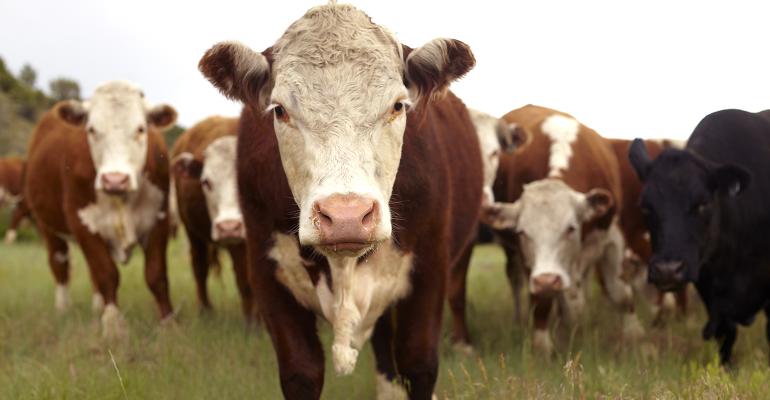
Cattle futures prices remain in a very slow, cautious uptrend on daily, weekly and monthly charts. The underlying friendly fundamentals are keeping the market overall well supported. The most recent USDA Cattle on Feed report confirmed the cattle herd is continuing to shrink, and high beef prices will likely be with consumers for some time.
Cattle in feedlots came in at 98% of a year ago. High input costs and, more importantly, enduring drought conditions in the western half of the United States have been a detrimental combo that cow calf and backgrounders have suffered.
The uptrend may be slowing
How long will the cattle rally last? When will it come to an end? The reality of tight supplies is priced into the market for cattle futures for both nearby and deferred contracts. Live cattle futures are gaining in proximity to the $171.97/cwt price high from October 2014. As futures prices approach those all-time highs, the rally does seem to be slowing, with traders cautious about how high prices could actually go, and when prices may finally start to top out.
Can demand stay strong?
Regarding domestic demand for beef, the American consumer continues to deal with food inflation, and retail beef prices are no exception. In recent months, beef prices have remained elevated with the average retail price at $7.37 per pound. In my opinion, as long as Americans have jobs, they will continue to pay for higher priced beef. They may opt for smaller portions or a lesser quality cut, but the demand is there.
Looking abroad, beef export demand looks strong overall, too. 2022 beef export value already set a record of nearly $11 billion for the full year. Export volume in the 11 months January-November was 1.36 million metric tons, a 3% increase over 2021’s record levels.
Risk management tips
Being a cattle producer is tricky right now. The good news is that your product is in high demand, but the bad news is the reality of the cost of doing business, let alone being able to secure feed in some locations.
Let’s look at feeder cattle. If you are seeking supplies, you may have to pay a lot more than desired due to tight supplies. How do you manage the risk? If you have not yet bought feeders and are intending to, you may want to guard against upside price risk. You could either buy futures (margin call risk) or buy call options. Call options provide the right (not the obligation) to own futures at a fixed price level. Once actual feeder cattle are purchased, you would then lift the long (bought) futures or call position.
On the flip side, if you have feeders to sell, some might consider purchasing put options that provide the right (not the obligation) to sell futures. Puts are attractive, as they leave the upside open for price appreciation while establishing a price floor.
If you are feeding cattle through to slaughter weight, then you might consider two risk avenues: pricing your end product and managing feed costs. Pricing your end product refers to the time cattle will be marketed. If you like a price, you could hedge (sell futures – margin risk). If you prefer to leave upside price potential in place, then purchase puts on live cattle contracts.
Feed costs right now are still historically high, and depending on how Mother Nature cooperates during 2023, grain prices could either re-test the 2022 price highs, or begin to slide lower back to “normal.” Pasture conditions could improve dramatically or still be a challenge in other locations. There are also ways to protect feed values with use of marketing strategies. Spend time with your marketing advisor and review your alternatives with knowledge of the risks and rewards.
Thankfully demand for beef is strong, there is no sign of a top, and as long as people still have jobs, demand for beef should stay consistent. Yet, be aware that prices are historically near the all-time price highs, and prices do not stay high forever.
Reach Naomi Blohm at 800-334-9779, on Twitter: @naomiblohm, and at [email protected].
Disclaimer: The data contained herein is believed to be drawn from reliable sources but cannot be guaranteed. Individuals acting on this information are responsible for their own actions. Commodity trading may not be suitable for all recipients of this report. Futures and options trading involve significant risk of loss and may not be suitable for everyone. Therefore, carefully consider whether such trading is suitable for you in light of your financial condition. Examples of seasonal price moves or extreme market conditions are not meant to imply that such moves or conditions are common occurrences or likely to occur. Futures prices have already factored in the seasonal aspects of supply and demand. No representation is being made that scenario planning, strategy or discipline will guarantee success or profits. Any decisions you may make to buy, sell or hold a futures or options position on such research are entirely your own and not in any way deemed to be endorsed by or attributed to Total Farm Marketing. Total Farm Marketing and TFM refer to Stewart-Peterson Group Inc., Stewart-Peterson Inc., and SP Risk Services LLC. Stewart-Peterson Group Inc. is registered with the Commodity Futures Trading Commission (CFTC) as an introducing broker and is a member of National Futures Association. SP Risk Services, LLC is an insurance agency and an equal opportunity provider. Stewart-Peterson Inc. is a publishing company. A customer may have relationships with all three companies. SP Risk Services LLC and Stewart-Peterson Inc. are wholly owned by Stewart-Peterson Group Inc. unless otherwise noted, services referenced are services of Stewart-Peterson Group Inc. Presented for solicitation.
The opinions of the author are not necessarily those of Farm Futures or Farm Progress.
About the Author(s)
You May Also Like






